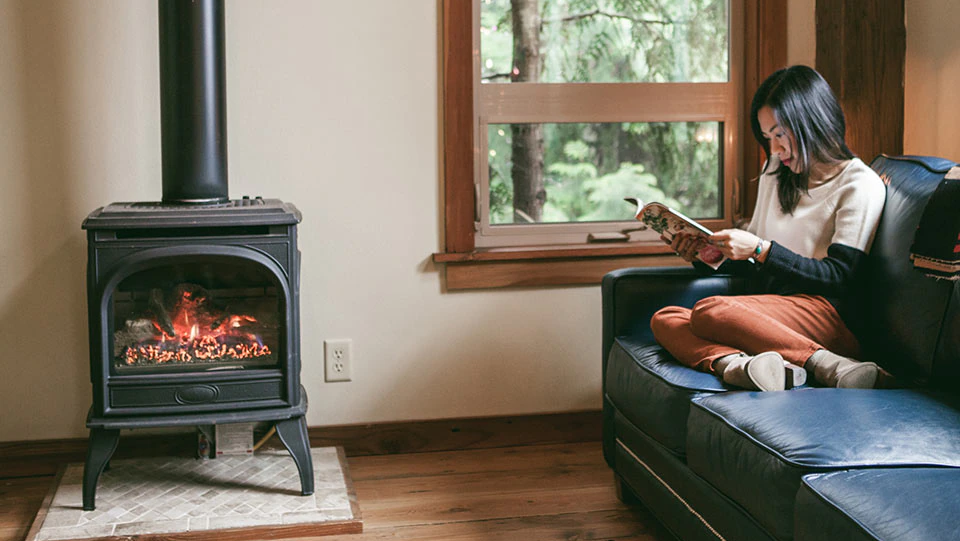Tips to Help Prevent Carbon Monoxide Poisoning
Carbon Monoxide (CO) is a colorless, odorless gas produced by the incomplete burning of any carbon-containing material, including gasoline, natural gas, propane, coal or wood. CO is dangerous because it replaces oxygen in the blood and interferes with the transport of needed oxygen to cells in the body.
Carbon Monoxide Safety Tips
(DESCRIPTION)
Travelers logo. A man in shirt with the Travelers logo stands beside a podium with a carbon monoxide detector on it and points his nose in the air.
(SPEECH)
SCOTT: Smell anything? I don't, but I hear that.
(DESCRIPTION)
He points at the detector.
(SPEECH)
It means that deadly carbon monoxide has entered your home.
(DESCRIPTION)
He holds up the detector.
(SPEECH)
A detector like this is the best way to know if carbon monoxide is in the air. Install one on every level of your home, near the bedrooms, and anywhere else it's required by law, then test them frequently. If a detector ever goes off, get outside quickly and call 911.
I'm Scott. I'm a safety consultant at Travelers. Learn more about how to prepare and prevent accidents at travelers.com/carbonmonoxidesafety.
[MUSIC PLAYING]
(DESCRIPTION)
Logo, Travelers, It's better under the umbrella. Text, The information provided in this video is intended for use as a guideline and is not intended as, nor does it constitute, legal, technical or professional advice. Travelers does not warrant that adherence to, or compliance with, any recommendations, best practices, or guidelines will result in a particular outcome. In no event will Travelers or any of its subsidiaries or affiliates be liable or in contract to anyone who has access to or uses the information provided in the video. Travelers does not warrant that the information in the video constitutes a complete and finite list of each and every item or procedure related to the topics or issues referenced herein. Furthermore, federal, state, or local laws, regulations, standards or codes may change from time to time, and the reader should always refer to the most current requirements. The material does not amend, or otherwise affect, the provisions or coverages of any insurance policy or bond issued by Travelers, nor is it a representation that coverage does or does not exist for any particular claim or loss under any such policy or bond. Coverage depends on the facts and circumstances involved in the claim or loss, all applicable policy or bond provisions, and any applicable law.
Many incidents involving carbon monoxide poisoning can be prevented with the right preparation. Start with these seven tips to help keep your home and family safe from carbon monoxide.
1. Know the risks of CO poisoning.
Anything that burns a fuel—such as a furnace, fireplace, generator, gas appliance or vehicles—produces a toxic by-product: CO.
When equipment is properly maintained and vented, this colorless, odorless gas can be effectively dispersed and safely vented. If not, inhaling CO can result in serious health issues.
At lower concentrations, victims may experience symptoms such as headache, dizziness, weakness, nausea, vomiting, chest pain and confusion. But at higher concentrations, CO poisoning can quickly cause loss of consciousness and even death.
2. Keep your vents clear.
During and after a storm, make sure nothing is obstructing the outside stack or vent for your gas dryer, stove, furnace and fireplace.
Take special care to prevent snow from building up and blocking these critical exits for CO.
3. Don’t run engines in a closed area.
Proper ventilation is critical to avoiding CO poisoning. So don’t start a car, fire up a grill or stove, or run a generator in a closed area like a basement or garage.
Even if you leave the garage door open, CO gas can quickly build up to toxic levels.
4. Schedule regular maintenance.
Make sure you rely on experts to install your fuel-burning appliances and set up the appropriate venting for each device.
At least once a year, have a qualified professional inspect your fuel-burning appliances to make sure they continue to operate properly.
5. Keep fireplaces clean and well vented.
If you have a wood-burning fireplace or stove, make sure you keep it clean and ensure that the flue is working properly.
Even if the last embers are just smoldering, keep the flue open to let gases escape.
6. Install CO alarms.
If you have fuel-burning appliances, a fireplace or an attached garage, consider installing CO alarms in your home. Install alarms outside of each sleeping area, on every level of the home and in other locations required by any applicable laws/building codes.
Some CO detectors can even be interconnected across your house, so that when one detects an issue, they all sound the alarm. If you do hear the CO alarm, immediately move to fresh air and call 911.
7. Maintain your CO alarms.
Keep in mind that CO alarms do need to be maintained regularly.
Many come equipped with a battery backup to help ensure uninterrupted operation, even if the power goes out. But you will need to remember to change your batteries at the frequency recommended by the manufacturer, like you do with your smoke detectors.
It’s also a good idea to keep a supply of batteries on hand in the event of a multi-day power outage. Other maintenance tips to consider are removing visible dust with a vacuum and testing and replacing units (check your owner’s manual for details).
In addition to protecting yourself and your loved ones from carbon monoxide poisoning, it’s important to have the right homeowners insurance to safeguard the things you value. Contact an insurance agent, get a quote, or speak to a Travelers representative to make sure you have the coverage you need.
This content is for general information only. It is not intended to provide legal, technical or other professional advice, nor is it an endorsement of any particular product. In no event will Travelers or any of its subsidiaries or affiliates be liable in contract or in tort to anyone for the accuracy or completeness of this information. Laws, regulations, standards or codes may change from time to time, and you should always refer to the most current requirements. This information does not amend, or otherwise affect, the provisions or coverages of any insurance policy issued by Travelers, nor is it a representation that coverage does or does not exist for any particular claim or loss under any such policy.




